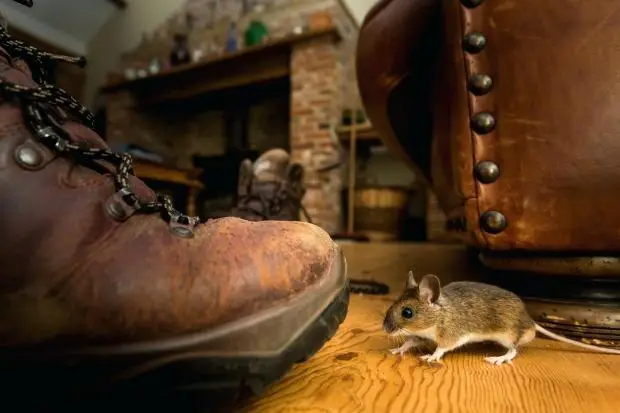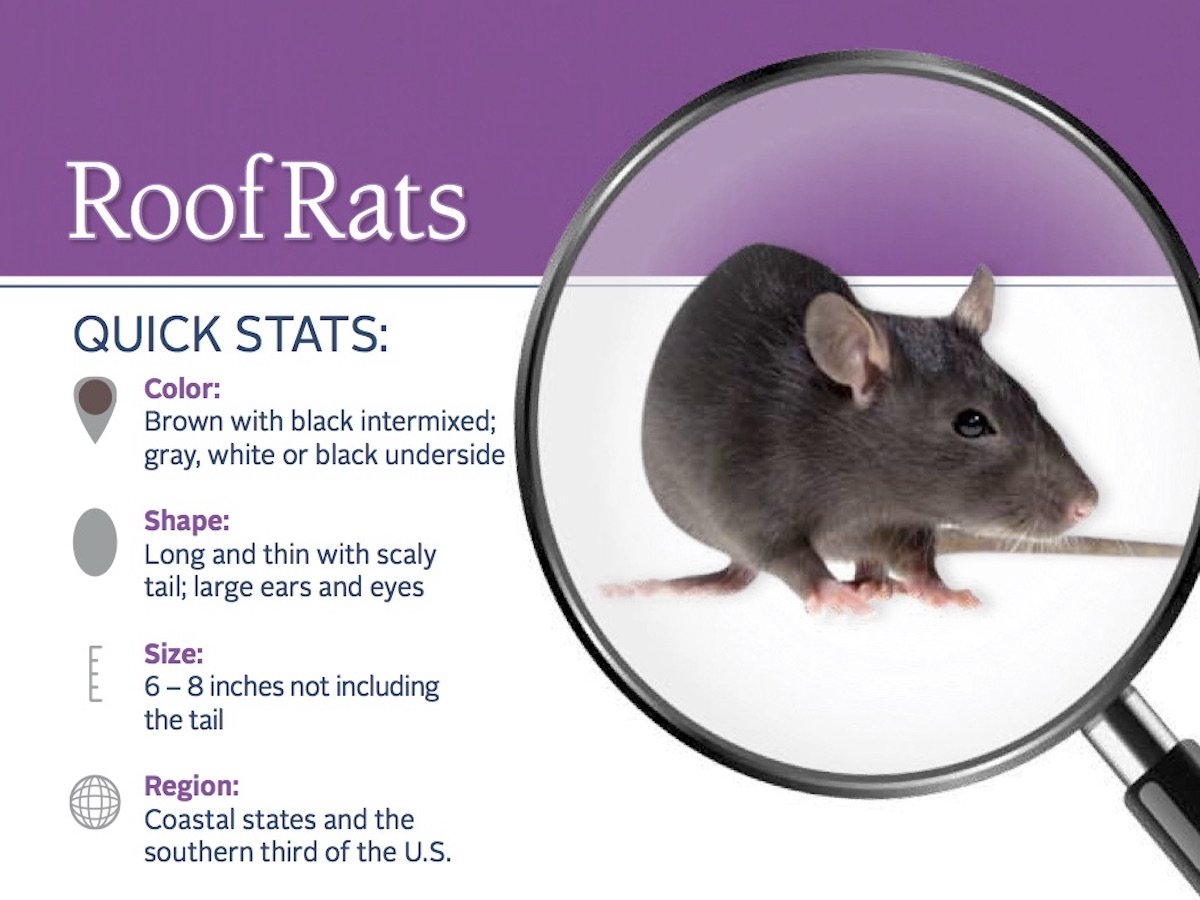Controlling Rats On Your Own
There are two steps experts recommend to deal with rats in and around the home: prevention and eradication.
To prevent rats from getting into your house, first, make sure they arent attracted to your yard and home in the first place. Remove wood piles and brush, and mow weeds and grass regularly. Dont leave pet food outside and clean up spilled food from bird feeders or chicken coops. Clear away acorns and other potential food sources from your yard.
Check for access points to your home. Inspect your roof and siding as well as any crawl spaces under the house. If they have no easy way inside your home, they may look elsewhere.
If youre unlucky enough to have rats in your home, you can trap them and relocate them with live traps. These are humane and safe options. Using poison is not a good idea, as other animals can get into the poison , and you cannot control where rats die. We also discourage sticky traps and snap traps where possible, as both can injure rats without killing them.
Remove And Prevent Roof Rats
Rats on your property are never ideal, especially when they’re inside your home. The noise of their scurrying can keep you up at night and they leave debris and feces wherever they travel.
Roof rats are one of the two most popular species of rats in the United States. As their name suggests, they like high places around your property but can also invade your home. Read this guide to learn more about how to identify and control roof rats.
The Ideal Rat Habitat
Rats love greenbelt areas with access to water, lush vegetation, seeds and other food sources. They eat nuts, seeds, vegetables and fruit, worms, lizards and various bugs, including spiders and roaches. When desperate, theyll eat green plants, paper or even candle wax. Rats frequent areas with lots of pecan trees and they also find acorns from live oak trees to be quite tasty. So yes, rats eat acornsas do mice and other rodents.
During the summer months, roof rats often are able to fend for themselves in our green spaces as well as gardens and homes with outdoor pets or chickens. Rats dont stay outside, however. They can find openings in the roof of your home, including areas in the fascia and soffits, and nest in your attic or walls.
Holes as small as a quarter are no challenge to a roof rat, and once inside, your attic provides a safe and comfortable place for them to reproduce. They tend to gather together to protect each other and travel in packs, and they can have as many as 60 babies in a single year. That means its highly likely that once a rat finds his way into your home, many more will follow.
You May Like: How To Measure Your Roof For Metal
Preventing A Roof Rat Infestation
Like all pests, roof rats need regular access to shelter, food, and water. If denied these things, theyll typically move on from your home to an easier target. Homeowners who take proactive steps to keep their yard clean, pick up food waste, and seal off entry points are typically less likely to have a roof rat infestation.
Are Rats Driving You Nuts

Rats are an ever-present issue in urban areas. Dont let them worry you. Give ABC Home & Commercial Services a call. We have pest control experts who can come out to your home and find solutions to your rat problem. We offer humane and environmentally-friendly solutions that will bring you peace of mind.
You May Like: What Is A Roofing Square Equal To
How Should I Handle Dead Rats Rat Droppings And Nesting Areas
- Use rubber gloves
- Ventilate the affected area the night before cleanup by opening doors and windows
- Spray dead rats, droppings, nests and surrounding areas with a 10% bleach solution
- Allow at least 15 minutes of contact time before removal
- Clean the affected area with paper towels or a mop
- Do not sweep or vacuum. Double bag both the disinfectant-soaked rat and cleanup materials securely in plastic bags and seal
- Dispose in city trash containers
- Before removing gloves, wash in disinfectant, then soap and water
- Dispose of gloves with other household waste. Thoroughly wash hands with soap and water
Home And Landscaping Tips
To reduce a propertys appeal to roof rats, tell your customers to:
- Use caulk to seal all entries that provide rodent access. They can enter through spaces that measure 0.25 in or larger
- Place screens over roof vents and attic turbine ventilators.
- Use a chimney cap or screen to protect the furnace and fireplace.
- Block entryways under sinks, near washers, dryers, dishwashers & hot water heaters.
- Always shut doors when exiting the home.
- Make sure all window screens are in good condition.
- Prune shrub and tree branches or limbs to within three feet of the structure and roof.
- Keep palm trees trimmed.
- Take down vines or shrubs growing against or near the building.
- Thin out bushes near the building.
Don’t Miss: How Many Feet In A Roofing Square
Where Do Roof Rats Live
Roof rats are appropriately named for their extraordinary abilities to climb great heights they are able to traverse slender power lines and rooftops with their remarkable agility and balance attributes. If roof rats managed to invade your home, it is likely do some sort of damage on your roof. Found nesting in attic spaces, areas just above ceilings, in the upper spaces of cabinets, as well as behind walls in your home, roof rats prefer higher areas. Roof rats will opt to nest in above ground vegetation to provide adequate protection, such as trees, when they are outside in their natural environments. Though they are perfectly content living outdoors, they are highly adaptable and can survive indoors just as easily. Generally, roof rats will invade homes and business in search for food and water when it is otherwise scarce. They will also escape the colder temperatures by going into warm buildings. With their high-rate of reproduction, their population can quickly spiral out of control which is why it is crucial you invest in professional pest control services if you suspect or seen roof rats in your home or business. They will contaminate surfaces, food supply, as well as cost owners financially for needed repairs in the structure and utility lines.
Winning The Battle Against The Roof Rat How To Control Roof Rats
Getting rid of roof rats can be an incredibly challenging task. A successful roof rat control asks for a multi-pronged attack. South Africas KZN Department of Health has enlisted the following steps to have a roof rat proof home:
- Remove Food Sources: Black rats are hungry creatures. They will frequent places where there is an abundance of food. Obviously, the first step in getting rid of roof rats is to eliminate easy access to food:
- Food should be stored in tight containers
- Garbage cans should be covered properly
- Clean bird feeders and pet feeders at regular intervals
- Pick up fruits and nuts fallen on the ground as well as harvested fruits
Read Also: How Long Should An Asphalt Shingle Roof Last
How Do Roof Rats Multiply
Roof Rats end up being sexually fully grown in only a couple of months. Females end up being sexually fully grown in 68-90 days with 5-8 puppies per litter. They have 4-6 litters annually. Because the Roof Rat climbs well, typical nesting sites are above the ground.
Like squirrels, they enter houses and are found in attics. Thick greenery, lush landscapes, fruit trees, and pet dog areas will all bring in roof rats. They will also build globular leafy nests in trees and get in buildings by tree branches, and energy lines.
What Roof Rats Dont Eat
Roof rats dont eat wood, plastic, aluminum, soft metals, they only chew them and damage them to make a path where they can hide. Roof rats dont eat venomous animals like scorpions. Also, Roof rats dont eat olives. Roof rats dont like the smell of naphthalene, eucalyptus oil, peppermint oil, and mothballs, so they dont eat them and stay away from them.
Also Check: How Much Is A New Roof And Gutters
Learn All About Roof Rats And How To Stop Them
Have you noticed rats on your roof? Knowing how to recognize rats can assist you in confirming infestations. Roof rats are smaller than house rats, with hairless ears and dark tails. They are a common sight in homes and yards.
Notoriously hard to get rid of, roof rats are known to have spread the bubonic plague in the middle Ages that decimated Europe. They continue to pose a menace to people to this day, causing structural damages by eroding the foundations of walkways, buildings, and roadways. In addition, they are ectoparasite carriers.
While some people have little to no trouble with rodents, some places are more prone to rodent infestations than others. If you reside in one of these areas, roof rats may find their way into your attic, causing a slew of difficulties for your family and property.
Hence, identification of roof rats, signs of infestation, knowing their nesting and food habits, and ways to get rid of them will help control and eradicate rats.
Nesting Habits Of Roof Rats

These rats nest in the upper parts of buildings. They are also found in and around buildings, and under structures. Inside a home, they are found behind walls, attics, above false ceilings, and cabinets tops.
Roof rats are arboreal, meaning that they prefer to live in the trees. They prefer yards with nut or fruit-bearing trees when foraging outdoors. They are attracted to lush landscapes, dense vegetation and prefer covered or sheltered habitats. Hence, rat infestations are more common in homes with woodpiles, heavy shrubbery, and storage boxes.
You May Like: Do I Need A Permit To Replace My Roof
Food Habits What Do Roof Rats Like To Eat
Roof rat diet mostly consists of vegetarian food. A roof rat needs about ½ to 1 ounce of food daily. In the wild, tree rats eat vegetative food like fruits, berries, and nuts. Their favorite fruits include fruits like avocados, coconuts, sugar-cane and citrus fruits. It also feeds on leaves, plant stems, tree barks, seeds, cocoa, coffee beans, and grains.
If needed, they may also follow an omnivorous diet eating food like snails, insects, lizards, and slugs.
In farms, they often eat through food items stored in storage rooms or processing facilities. They may also eat on food provided to domesticated animals like cows, chickens, and even canine and feline food.
According to Almeda County Vector Control, roof rats living in cities often eat pet food, bird food, and food found in garbage and trash cans.
Roof rats consume about 1 ounce of water daily. They drink water from leaky pipes, pets water bowls, irrigation pipes, and even high bird baths to suffice their water requirements.
How Do They Reproduce
Roof rats are social animals and form groups with multiple males and females. There is a linear hierarchy with one dominant male and two or three dominant females to other members. Females are more aggressive than males. The dominant male would be a successful breeder. Roof rats are territorial and extremely protective of their fellow group members. Roof rats do not have a mating season per se, but they are more active during the summer months. The females can produce five litters in a year. The female roof rat gestation period is 22-24 days, after which a litter of eight young ones is born on average in the nest. The young ones, when born, are underdeveloped, and it will take 14-17 days for them to open their eyes. Weaning occurs after three or four weeks and they are milk-fed until then. After weaning, they will leave the nest.
Recommended Reading: What Is The Average Life Of A Roof
Once The Baby Is Big Enough To Eat You Can They Try Rat Blocks Etc
What do baby roof rats eat. So what do wild rats eat, anyway? Roof rats are long and thin rodents that have large eyes and ears, a pointed nose and a scaly tail. While these critters are just as intelligent as other varieties, they have a picky palette.
Onions and garlic have an overwhelming smell that rats hate, but it is the capsaicin in peppers. From rat bites and scratches to saliva and urine, rats can cause many diseases. They basically eat anything a human eats and more.
Originating in southeast asia, roof rats get their name from their love of climbing and living in high buildings. They have often been dubbed a ship rat because they love to burrow into crates being shipped and were usually found aboard boats. Naturally, they will eat in several different places, which will be an important strategy when you bait and.
Rats love the smell of most vegetable matter. Roof rats are food hoarders, stashing supplies of food such as seeds and nuts. Not only do rats love to eat, they also love to drink.
Baby rats eat around six or more times a day. Naturally, they will feed in a number of different places, which will be an important technique when you bait and trap. They find it very inviting, but certain types of veg can be used to keep them from setting up home.
Roof rats will eat meat and grain, but their preferences are fresh fruits, vegetables, seeds, and nuts. To give them as a food. Do rats keep roaches away.
Roaches are afraid of rats because they are a danger to them.
Why You Have Roof Rats
Do you have a roof rat problem? Youre not alone. These mammals with the Latin name Rattus rattus are widely distributed throughout the US and have been known to be called by several different monikers, including black rat and ship rat. They are more at home in warmer climates so are typically found in large numbers along the lower half of the East Coast and through the Southern states along with the Pacific Coast and Pacific Northwest. Why do you have them in your facility? There are several factors that could cause a roof rat problem and, if they arent rectified, these pests are going to cause you to lose product, profit and even customers.
Recommended Reading: How Do I Install A Metal Roof
What Do Rats Eat In The Wild
Most wild American rats are opportunistic omnivorous feeders and, as you may be aware, will eat whatever is available to them.
They basically eat anything a human eats and more.
All rats eat grains, and some will also eat meat and fish.
Others enjoy fruit, vegetables, nuts, seeds, eggs, milk, and candy.
Wild rats also eat bugs, insects, leather, fur and other rodents and small animals.
While they will mostly eat what they can find, they can occasionally hunt as well.
What do rats eat in urban areas?
Rats that live in cities will eat whatever they can get access to in garbage cans, landfills, bird feeders, pet food .
They can also be found near livestock feed stores, garages, cellar doors, fruit or nut trees, dumpsters, compost bins, or anywhere food or food waste is stored.
Rats may only be small but they eat constantly.
The glutinous little rodents can consume up to 1/3 of their body weight each day.
Think Templeton from Charlotte’s Web or from Emile from Disney Pixar’s Ratatouille, both characters are quite accurately depicted eating at every opportunity!
Where rats are provided with a choice of different foods, they will try at least a small sample of each.
Though they do eat A LOT, rats are generally weary of new foods.
If they do try a new food, they will usually only sample a small amount to begin with, to be sure it is safe and digestible.
Trapping, if necessary, can therefore be more effective if the trap is initially baited but not set.
Why Is The Black Rat Considered To Be An Invasive Species
The Roof Rat is believed to be a very invasive species. They result in deep devastation of native vegetation and animal life. They eat away vegetation at a rapid pace, sometimes leading to the extinction of local vegetation. They transmit deadly diseases to local animal species and compete for their food and shelter, often resulting in an irreversible negative effect on local fauna.
Recommended Reading: A Team Roofing Collierville Tn
How Much Is It Going To Cost Me
You may think a high tech device such as the Ultrasonic Rat Repellent might cost you a pretty penny, but on the contrary! This permanent rat control solution can be yours for the very low price of $59.95 $29.95 ! Purchase this revolutionary produce direct from Pest Destruct official retailer today! The potential for this device is absolutely infinite!
What Do Roof Rats Eat

Roof rats are omnivorous and willing to eat practically anything available to them. However, they prefer to feed on seeds, nuts, fruits and berries when in season. Additionally, they will feed on slugs and snails, which may become a large part of their diet. Roof rats also feed on insects including American and brown cockroaches. If they live near bodies of water, they will eat fish, shellfish and other aquatic organisms.
Roof rats typically feed at dusk and again prior to dawn, although they will forage several times per night and during the day. Roof rats in particular are food hoarders, meaning that they have been known to stash supplies of things such as nuts and seeds. When eating, they prefer to be in a sheltered or hidden environment.
Read Also: Does Insurance Cover Storm Damage To Roof
